OTTAWA—A report on the state of Canada’s freshwater resources is taking current and past federal governments to task for using the Great Lakes as “a dumping ground for our toxic waste, and more recently, as a carbon corridor to transport tar sands bitumen, fracked gas and fracking wastewater.”
‘Blue Betrayal,’ a report authored by Maude Barlow of the Council of Canadians, a non-governmental organization, paints a damning portrait of the current ruling Conservative federal government’s stewardship of Canada’s freshwater resources, but does not let past governments of any political stripe off the hook.
“The Council’s report touches on many elements of what New Democrats have been saying for years,” said Algoma-Manitoulin-Kapuskasing MP Carol Hughes. “We led the fight against the Conservative’s all-out war on our environment. The way they dismantled our institutions, laws, and regulations by tucking that work into massive budget bills was designed to slip under the radar. That said, I think that Ed Broadbent’s comments last week should be considered as well. He reminded us that much of what Stephen Harper has dismantled was not that great to begin with, which is why I am glad that Maude Barlow did not give a free pass to past Liberal governments in her report.”
The work is ongoing, however. “This doesn’t mean that we shouldn’t be working as hard as we can to protect all of our freshwater resources, especially the Great Lakes that hold 20 percent of the world’s surface fresh water,” said Ms. Hughes. “I think we have to look at how a concentrated effort to draft and enact strong legislation brought Lake Erie back from the brink in the early 1970s and take some inspiration from that. New Democrats moved a motion through Parliament last week that will ban plastic microbeads in consumer toiletry products. It is an example of what Parliament can and should be doing. What cannot happen is for the environment to be run down in the name of ‘economic progress’ because that is a short sighted and dangerous way for us to behave.”
The report was released just after World Water Day, marked on Sunday, March 22, and the picture it paints is not a healthy portrait of the Great Lakes.
As many as 40 million people in Canada and US depend on the Great Lakes for their incomes, but the report points out those waters now contain at least 204 pollutants, including plastic in various forms.
The report goes on to point out that the bodies of the fish in the Great Lakes are packed with heavy metal contaminants including mercury, dioxins and lead.
Just as worrying for environmentalists, noted the report, is blue-green algae, which has made a startling comeback over the past few years.
Algonquin Eco Watch’s Mike Wilton said that he is in full agreement with what is contained in the report. “We are taking the Great Lakes for granted and all of our freshwater resources for granted,” he said. “It is time we woke up and take a look at what is happening around us.”
The key challenges facing the Great Lakes are the twinned factors of industrialization and population growth, noted Mr. Wilton. “That and diversion to the United States.”
Ms. Barlow’s report “really raised a red flag,” said Mr. Wilton. “American states are running out of water,” he said. “There is going to be a big push to divert north flowing rivers back over the watershed with dams so they flow south and into Lake Superior.” He noted that the precedent was set during the Second World War when the Albany River was diverted to flow into Lake Nipigon, then onto Superior.
If there are efforts to switch the flow of water into the North there will be dire consequences for many First Nation communities, he pointed out.
“The other elephant in the room is that fresh water is disappearing, Canadians had better wake up fast,” he said. “Canadians have a false sense of security, particularly with the water that is sitting on top of the permafrost. Nobody knows what lies underneath that frozen reserve. It may well be dry beneath.” When the rising global temperatures thaw that water out, it could flow down into a hitherto undiscovered dry basin beneath the frozen surface.
A United Nations report, released in New Delhi last week, also warned there could be a 40 percent shortfall in water globally within 15 years unless countries dramatically change their use of the globe’s freshwater resources.
Adding to the pressure globally is the fact that the earth’s population will grow to over nine billion by 2050, if projections are at all accurate, and even more groundwater will sucked up for use in agriculture, industry and personal consumption, reads that report.
In fact, adds the report, projections show that demand for water will increase 55 percent by 2050.
The underground water reserves that have so far shielded major agricultural regions such as California from that impact are running dangerously low and, having been laid down prior to the last ice age, are a finite resource. Added to that, rainfall patterns are predicted to become more erratic with as the earth’s climate changes.




